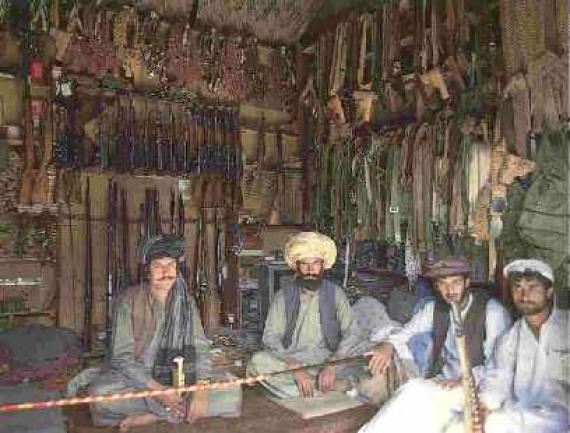Pakistan’s Village of Illegal Guns

Pakistan and Afghanistan are both economically depressed, with a per capita GDP of roughly $3,500 and $1,000 respectively. Yet both of these nations have many well-armed men, at least relative to the typical Westerner. With money tight, infrastructure rare, and even literacy often lacking, where do the guns come from?
The answer: a small town called Darra Adam Khel.
Located in Pakistan south of Peshawar and near the Afghan border, Darra Adam Khel (or simply Darra, for short) is, as the Washington Post described it in a headline, “like the Wild, Wild West — plus Al-Qaeda.” The town is in one of a half-dozen frontier regions which are considered “Federally Administered Tribal Areas,” or “FATAs.” FATAs are exempt from many of the laws passed by the Pakistani government. Instead, Darra is administered by the Frontier Crimes Regulations, which, in turn, gives individual tribes in each area the power and responsibility to govern its people, and with wide discretion. In practice, this means that the town of Darra is outside the purview of Pakistan proper — and its people take advantage of this.
There is only one main road in Darra and it is filled, on either side, with ramshackle stores. The stores sell guns of all makes and sizes. But these weapons aren’t imported by some shady arms dealer; they didn’t fall off the back of the proverbial truck; and they aren’t procured via some conspiracy theorist’s delusions of a classified CIA program to arm insurgents. Rather, the Darra people make them.
Using only “hand tools and a small drill press” per Wikipedia, men in Darra create illegal replicas of firearms all day, every day. The gun-making skills are passed down from generation to generation, treated like any craftsman’s trade. The variety of weapon is virtually limitless, stretching from hand guns and pen pistols to rifles and even grenade launchers. In spite of this informal education and their relative primitive tools, these weaponsmiths can recreate a gun that they have never seen before, typically in under a few weeks. And in most cases, the replicas come out as nearly perfect copies.
The number of people living in Darra is unknown but believed to be in the ballpark of 50,000. An absurd number of them are involved in the gun trade — Atlas Obscura reports that 75% of the male population work in the “industry.” They aren’t all gun manufacturers, though. Some are the shopkeepers themselves, charged with brokering deals and collecting payments. Others act as try-before-you-buy salesmen; they run shooting ranges situated on top of the shops. And finally, some make sure tourists stay out of the area — outsiders are typically unwelcome — confiscating anything purchased by someone unauthorized by the tribes.
The town is often discussed as one of the most dangerous places in the world, and, given its product line and clientele — often, extremists aligned with al-Qaeda, the Taliban, or similar groups — the description seems apt.
Bonus fact: The name “Pakistan” comes from a 1933 pamphlet titled “Now or Never,” written by Choudhary Rahmat Ali, an activist who wanted to create a Muslim homeland in South Asia. It is an acronym, per the pamphlet, for “the five Northern parts of India” which were heavily comprised of Muslims: Punjab, the Afghan Province, Kashmir, Sind, and Baluchistan. The original text called the envisioned country “Pakstan;” the “i” was added later in order to make the name linguistically correct.
From the Archives: Wagah Dance: An equally absurd feature on Pakistan’s other border, but a much less dangerous one (save for knee injuries).
Related: “Soldiers of God: With Islamic Warriors in Afghanistan and Pakistan” by Robert D. Kaplan. 4.5 stars on 27 reviews, originally published in November of 2001.
Image via Atlas Obscura

Leave a comment